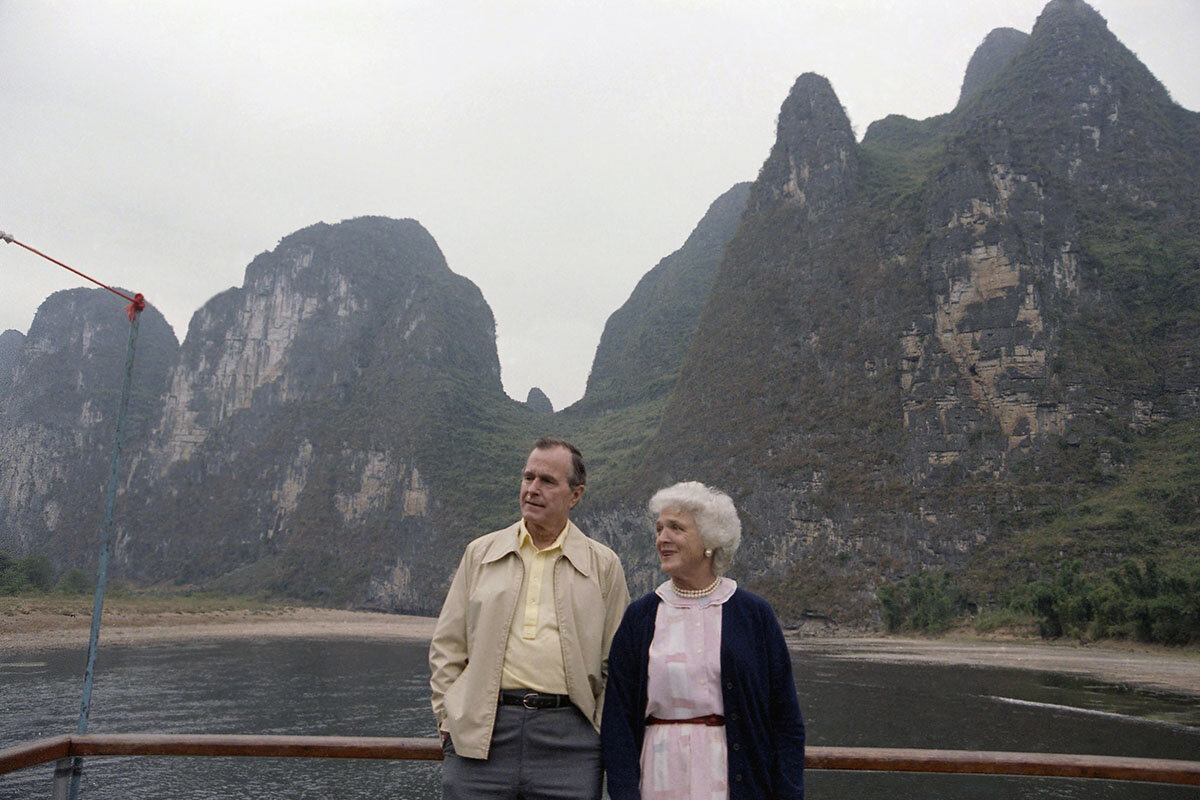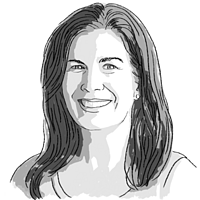Bush House: How the US ambassador’s home in China got its name
Loading...
| Beijing
As dusk falls on a crisp October evening in Beijing’s quiet Jianguomenwai embassy district, guests flow into 17 Guanghua Road, the stately yet unassuming residence of U.S. Ambassador Nicholas Burns and his wife, Elizabeth Baylies.
Persimmons ripen on trees nearby, and magpies flit around the ancient Altar of the Sun park across the street, where early risers often perform tai chi. People cycle slowly by. A solemn-faced Chinese army guard stands at attention at the gate.
Indeed, the house and its immediate surroundings bear similarities to what then-U.S. Ambassador George H.W. Bush found when he arrived here almost exactly 49 years ago, assuming his post as head of the United States Liaison Office in Beijing. At that time, Chairman Mao Zedong’s radical Cultural Revolution was ongoing, and ties between the two countries – estranged from 1949 until President Richard Nixon’s historic China trip in 1972 – were in their infancy.
Why We Wrote This
Nearly half a century ago, George H.W. Bush and his wife helped usher in a new era of U.S.-China relations. Though China looks different today, the couple’s leadership and perseverance still hold lessons for present-day diplomats.
“We swung into the mission: nice, clean, great-looking U.S. seal, two PLA [People’s Liberation Army] guards at the gate,” Mr. Bush wrote in his diary on Oct. 21, 1974, his first night in Beijing. He asked his wife, Barbara, to “get a ping-pong table and a couple of bicycles” as soon as she could. Then, as the wind howled at the windows, reminding him of West Texas, he went to bed early.
Last Friday, the dramatic sweep of five decades of U.S.-China relations seemed telescoped in time as the current occupants of 17 Guanghua Road celebrated that pioneering diplomatic couple – dedicating the house as “Bush House,” in honor of President Bush and first lady Barbara Bush. Despite vast changes, parallels exist between then and now: The two countries once again stand at a crucial juncture in their ties, are emerging from years with limited contacts, and struggle with fundamental differences even as they face the necessity to get along.
“This is the house where America returned to China in 1973, 50 years ago this summer, after an absence of 24 years,” Ambassador Burns told the gathering. “So with our celebration this evening, we honor the return of the United States to China. And we are here to stay in China this time.”
Finding connection
Mr. Bush had surprised his boss, President Gerald Ford, by turning down offers of two prestigious diplomatic posts – London and Paris. “He said, ‘With all due respect, I want to go to China,’” says Alexander “Hap” Ellis III, chair of the board of the George and Barbara Bush Foundation and Mr. Bush’s nephew, who attended the dedication. “He had this instinct that China was going to be a hugely important country.”
The early Beijing posting would prove formative for Mr. Bush’s understanding of foreign affairs and consequential for U.S.-China relations, as he became the only American ambassador to China to rise to the presidency.
To be sure, daily life in Beijing for the Bushes held a stark contrast to that of Mr. Burns and Ms. Baylies. Mr. Bush rode a bicycle – with a makeshift “Texas George” license plate – all around the city, sometimes donning goggles during dust storms. Iconic photos show the couple touring around markets and mingling with ordinary people, seemingly with little security.
Mr. Bush commented in his diary about drab clothing and a general lack of “gaiety,” cabbages stacked high on windowsills, and ubiquitous mule-drawn wagons that he thought would clog roads if China wanted to mobilize conventional military forces. He oversaw a tiny mission with nine U.S. diplomats, deciding he needed an “agricultural person” but no military attaché.
Life at 17 Guanghua Road is not as free for its current residents. Arriving at the now heavily gated residence after a long commute on Beijing’s traffic-clogged highways, Ambassador Burns – who oversees several hundred U.S. employees from 47 government agencies – laughs when asked if he envies aspects of how the Bushes got around. “Yes,” he says, recalling how Mr. Bush and his mother casually biked down to Beijing’s Tiananmen Square – no bodyguards, no armored cars.
“Libby and I actually walked, in our second or third month here, from here to Tiananmen, and I think we went through 13 police checkpoints,” he says. “We were stopped at one for about 20 minutes because they really couldn’t figure out what the American ambassador was doing walking through Tiananmen.”
Still, the couple find ways to connect with people. Like the Bushes before them, they are both studying Chinese. They strike up conversations on second-class train rides and go to local sporting events, such as a recent Beijing soccer match. “We were seated with all sorts of people around us,” he says. They sported green scarves, the color of the local soccer club, which earned them high-fives from other spectators. “It was good,” he says.
Righting the ship
More broadly, some fundamental challenges remain similar for both ambassadors. Mr. Bush said he came to China “in spite of great warnings of isolation.” When Mr. Burns and Ms. Baylies arrived in February 2022, China was largely cut off from the world by its strict COVID-19 prevention regime, which kept out most foreign visitors for three years.
“We had that 21-day quarantine,” says Ms. Baylies. “We were lucky enough to be quarantined in this house.”
Exploring their new home during those wintry days of isolation, she says, “Nick was surprised that this house did not have a name,” and lit upon the idea of Bush House.
Mr. Bush labored to try to form personal connections with Chinese leaders, starting with soon-to-be paramount leader Deng Xiaoping. Years later, President Bush wrote that his longstanding friendship with Mr. Deng helped prevent Sino-American relations from “derailing.” Similarly, Mr. Burns has worked to rebuild high-level contacts severed by both pandemic policies and political tensions. In a positive turn, a string of U.S. Cabinet members, lawmakers, and other senior envoys have arrived in Beijing since June.
Even as they compete as “rivals” in key realms such as technology, China and the U.S. are now cooperating well on issues of climate change, agriculture, and people-to-people exchanges, he says.
“I feel good about the progress we’ve made in the last five months,” says Ambassador Burns.
The Chinese balloon crisis in early February “was kind of rock bottom in the relationship,” he adds. “We’ve righted the ship.”
One critical exception is military-to-military ties, which have yet to be restored.
“It’s frustrating,” he says. “There ought to be very close military-to-military contacts. We are working this issue with the Chinese as hard as we can, and it’s up to them. That’s one way you drive down the probability of any conflict,” which “would be catastrophic for both countries and the world,” he adds.
Mr. Bush also voiced many frustrations, but some notes of nostalgia entered his diary as he neared his departure. In July 1975, he wrote that he would not forget the sound of “early morning singing in the park” or “the jingle of bicycle bells.”
At Friday’s dedication, Chinese Executive Vice Minister of Foreign Affairs Ma Zhaoxu spoke of Mr. Bush’s belief in the ability of China and the U.S. to resolve their differences, and of his reluctance to leave Beijing in December 1975. Overall, Mr. Bush would make dozens of trips to China in his lifetime.
“I may forget the four tones of Mandarin I learned here,” Mr. Ma, speaking through a translator, quoted Mr. Bush as saying. “But I will never forget the warm hospitality of the Chinese people. Maybe no more than three weeks after I return home, I will already be wanting to come back to No. 17 Guanghua Road.”






